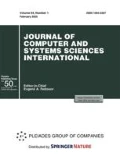Abstract
A new original approach to the formalization and implementation methods for the problem of inductive programming is described. This approach makes it possible for the first time to describe a wide range of problems within the given formalization based on examples from the implementation of problem-oriented languages to the development of applied systems with the help of these languages. Methods for passing on “procedure knowledge” that are accepted in information technologies and human communication are discussed and the concept of an “anthropomorphic information technology” is formulated. The general scheme for constructing this system based on the given technology is described. The fundamental role played by the mechanism of partial evaluation in providing the efficiency of implementation and maintenance of the extension mode for inductively specified languages is stressed. An example of inductive specification of a simple programming language and discuss the prospects of using the concept proposed is presented.
Similar content being viewed by others
References
R. Kalan, The Main Concepts of Neural Networks (Vil’Yams, St. Petersburg, 2001).
P. D. Summers, “A Methodology for LISP Program Construction from Examples,” ACM 24, 162–175 (1977).
G. M. Sergievsky and N. G. Volchenkov, Functional and Logic Programming (Akademiya, Moscow, 2010) [in Russian].
E. Kitzelmann, “Inductive Synthesis of Functional Programs: An Explanation Based Generalization Approach,” Machine Learning Research 7, 429–454 (2006).
Online Platform on Inductive Programming http://www.industive-rrogramming.org/.
E. Kitzelmann, Analytical Inductive Functional Programming, Lecture Notes in Computer Science, 2009, No. 5438, P. 87–102.
E. Kitzelmann and M. Hofmann, “IGOR2, an Analytical Inductive Functional Programming System: Tool Demo,” in ACM/SIGPLAN Workshop Partial Evaluation and Semantics-Based Program Manipulation Proceedings of the 2010 ACM SIGPLAN workshop on Partial evaluation and program manipulation Madrid, Spain, 2010.
S. H. Muggleton, “Inductive Logic Programming,” New Generation Computing 8((4)), 295–318 (1991).
S. H. Muggleton and L. De Raedt, “Inductive Logic Programming: Theory and Methods,” Logic Programming 19, 629–679 (1994).
H. Blockeel, J. Shavlik, and P. Tadepalli, in Proceedings of 17th Conference on Inductive Logic Programming ILP’2007 (Springer, 2007), p. 306.
W. David and B. A. Wolber, Myers Stimulus-Response PBD: Demonstrating “When” as Well as “What” in Your Wish Is My Command: Programming by Example, Ed. by H. Lieberman (Morgan Kaufmann Publishers, San Francisco, 2001), pp. 321–344.
Knowledge Discovery in Databases, Site of BASEGROUP Company: http://www.basegrour.ru/libraru/methodologu/kdd/.
O. P. Mosalov, V. G. Red’ko, and V. A. Nepomnyashchikh, A Model of Search Behavior of an Animat, Preprint: http://www.niisi.ru/iont/projests/rfbr/90197/Preprint.pdf.
Author information
Authors and Affiliations
Additional information
Original Russian Text © G.M. Sergievsky, 2011, published in Izvestiya Akademii Nauk. Teoriya i Sistemy Upravleniya, 2011, No. 1, pp. 40–53.
Rights and permissions
About this article
Cite this article
Sergievsky, G.M. Concept of inductive programming supporting anthropomorphic information technology. J. Comput. Syst. Sci. Int. 50, 38–50 (2011). https://doi.org/10.1134/S1064230711010163
Received:
Published:
Issue Date:
DOI: https://doi.org/10.1134/S1064230711010163




